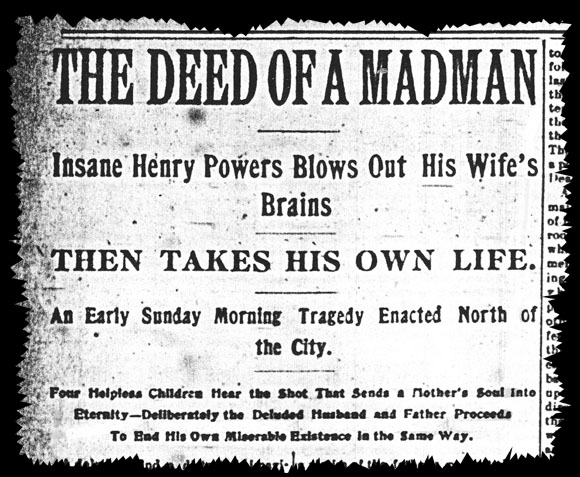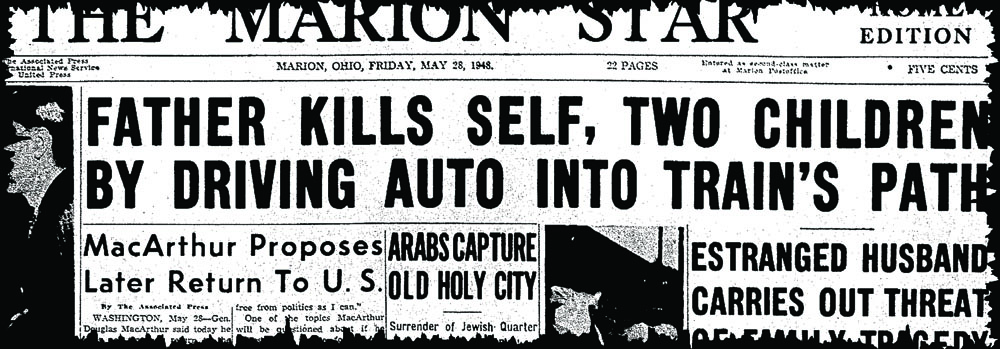On August 19th, 2011, a 55-year-old Marion man was arguing with his 46-year-old girlfriend when he pulled out a .357 caliber revolver and shot her in the head. He then turned the gun on himself. By the time first responders arrived at the Mark Street crime scene, both the man and woman were dead.
For the friends and family left behind after such murder-suicides, the grief and horror must be profound. Even for those of us who don’t know the people involved, such violence causes a complex mix of emotions: There is sadness, of course, that people have died in such unnatural ways. But there’s also frustration that the perpetrator of the murder will never have to face justice and perhaps answer the one question on everyone’s mind: Why? There’s also a deep sense of disquiet because the murderer and the victim(s), more often than not, know each other intimately. We think to ourselves If that woman just over on Mark Street could die at the hands of her boyfriend, then it could happen to me…
Sadly, this grim scenario has played itself out a number times in Marion over the years. “A Real Horror Story” is one such example, and the following two cases are equally bleak.
Insane Henry Powers
On Sunday morning, November 29th, 1896, 36-year-old Henry Powers sat down to breakfast with his wife and four children at their home on Marion-Bucyrus Road just north of the city. After breakfast the two older boys went out to play while Henry and his wife, 32-year-old Katherine, along with their teenage daughter and youngest son, stayed inside. According to a Marion Daily Star article that appeared the next day, although Henry had been showing signs of an “unsound mind” for some time, on the morning of the 29th, “He [was] quiet and undemonstrative.” It came as shock, then, when Katherine and her daughter, upon hearing a noise in the kitchen, found Henry standing there with a shotgun in his hands. Both women immediately turned to flee. Mrs. Powers ran toward the sitting room and Henry followed her. The daughter, Ella, ran for the door, and it was as she was racing outside that she heard the shotgun blast. The neighbors, alerted by Ella, watched from a distance as the still-armed Henry left the house trailed, shockingly, by Henry and Katherine’s youngest boy, 2-year-old Willie. Luckily, the two older Powers boys spotted their younger brother, grabbed him and carried him to the safety of Ella and the neighbors. As they all watched, Henry Powers disappeared behind the house, and they heard a second gun blast. Incredibly, Powers reappeared a few minutes later, gun still in hand, and with blood “streaming down over his face.” He disappeared back inside the house.

A messenger was sent to fetch the sheriff. The neighbors, unsure of whether Henry Powers was still dangerous, chose to wait with the Powers children at a safe distance. When the sheriff and the rest of his party eventually arrived and entered the house, they were met with a gruesome scene. According to the Star, “Mrs. Powers [lay] in a pool of blood [in the sitting room]. Half her head and face had been blown away, and her brains lay upon the floor beside her.” As for Henry Powers, his corpse was also found in the sitting room just a few feet from his wife’s body, and his wounds were likewise terrible: “In the left eye and directly above it was a large hole where the muzzle of the gun had been placed when discharged.”
Why did Henry Powers kill his wife and then himself? It appears the man had been mentally ill for a long time. According to the Star, most of his delusions centered around an “insane jealousy” of his wife. In May of that year, Powers had attempted to commit suicide by cutting his own throat with a straight razor. Shortly thereafter, a judge committed him to an asylum in Columbus. Five months later, however, the asylum’s superintendent, believing that Powers should given “one more chance,” released him.
Powers returned to his wife and family in Marion on October 16th. He wife was so surprised that he had been released that she believed the asylum must have made a mistake. In fact, fearing that Mr. Powers was still capable of carrying out “injury to himself or his family,” she had even contacted the sheriff about the possibility of returning Mr. Powers to the asylum. According to the Star, during the week prior to the tragedy, Powers was convinced that his wife had been trying to poison him. Tragically, it seems that the only thing poisoned in the Powers household was Mr. Powers’ mind, and ultimately the Powers family paid the price for it.
“It Was the Awfulest Thing I’ve Ever Seen in Almost 40 Years of Railroading”
On March 27th, 1948, 40-year-old Charles Gerstenlauer called his wife from a pay phone at Five Points, a lunch room and filling station once situated where Route 309 and Route 98 meet. In a disturbing conversation, Mr. Gerstenlauer told his wife, 38-year-old Elsie, that he was going to “do away” with himself and their two small children. The Gerstenlauers were in the middle of a particularly ugly divorce, and Charles, against Elsie’s protests, had taken the children earlier in the day from their home and disappeared. Immediately after receiving the call, Mrs. Gerstenlauer alerted authorities, and the search, which included members of the city police, the sheriff’s department and the highway patrol, got underway. However, by the time authorities located Mr. Gerstenlauer, he had already carried out the unthinkable.
Charles and Elsie Gerstenlauer had married in 1943 in South Carolina and moved to Marion in 1945 to take over Acme Dry Cleaners on Olney Avenue. In Marion, however, things seemed to sour for the couple, and in 1947 Elsie consulted an attorney about getting a divorce. On May 20th,1947, she filed for divorce, citing “gross neglect and extreme cruelty.” In fact, on the morning of the 27th, Mr. And Mrs. Gerstenlauer had been in court over Mr. Gerstenlauer’s violation of a restraining order.
Less than a quarter of a mile north of Route 309, a railroad crossing cuts across Route 98. John Dairy, the foreman of an Erie signal repair crew that was working in the area at the time, told the Star that he had noticed Mr. Gerstenlauer driving back and forth across the tracks all afternoon and thought it was a bit strange.
Another witness, Kenneth Carpenter, told the Star that he was following behind Mr. Gerstenlauer on Route 98 when Gerstenlauer stopped at the crossing, apparently waiting for the train approaching in the distance. Since the train was still a good ways off, Mr. Carpenter was initially irritated because he was running late and thought that, “[the man] still had plenty of time to cross safely [and] seemed pretty cautious.” However, the witness was dead wrong about Mr. Gerstenlauer’s intentions. Carpenter told the Star, “When the train was about 100 feet away, he drove his car right onto the tracks, and it looked like he stopped. The engineer never had a chance.”

The train, which was an Erie passenger train called the Lake Cities, was heading east and bound for Jersey City. By the time it was nearing Route 98, it was traveling at around 70 miles per hour. Mr. Gerstenlauer was thrown 200 feet from his car while the children were later found in it. Charles Lowe, the train engineer, told the Star that, “It was the awfulest thing I’ve ever seen in almost 40 years of railroading. I’ve been riding engines when they hit cars before, even people walking, but when I saw those two little girls it really hit me.” One has the impression Mr. Lowe and the other witnesses would be haunted by what they saw that day for a long, long time.
